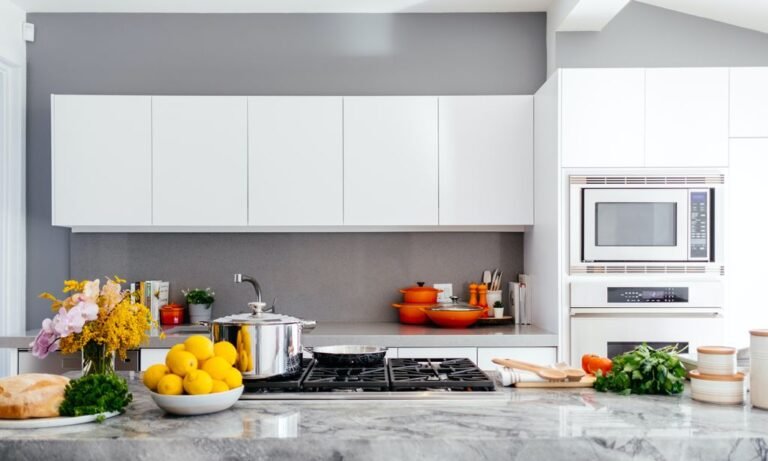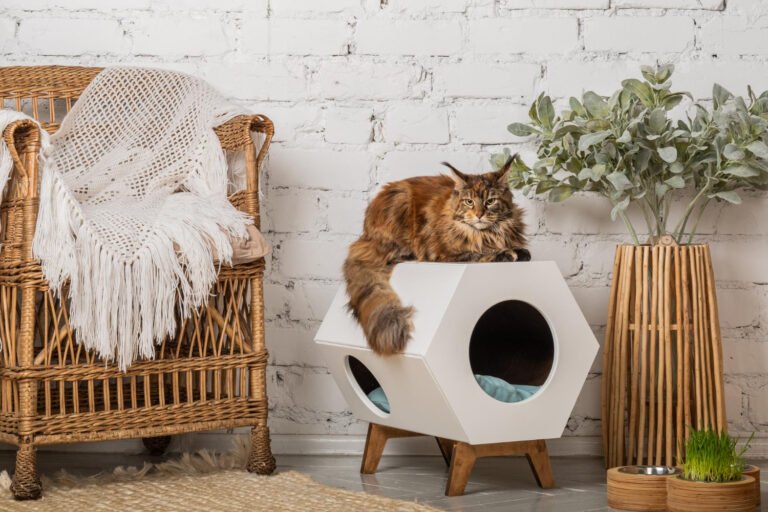Indoor Plants and Pets: Safe Choices and Placement Tips
In this guide to pet-friendly houseplants, you’ll find our top 5 suggestions with care tips for indoor plants and pet. The addition of houseplants to your interior space not only enhances the aesthetic appeal of your home but also contributes to a healthier environment for both you and your family. However, for pet owners, the concern of plant toxicity can make selecting greenery a daunting task. Fortunately, there is a large number of pet-friendly houseplants that can coexist harmoniously with our pets, bringing nature indoors without compromising their well-being.
Key Takeaways
- Research plant toxicity before purchasing
- Elevate plants out of reach of pets
- Designate pet-free zones for delicate or toxic plants
- Observe pet behavior around plants
- Regularly remove dead leaves and fallen plant parts
Choosing Pet-Friendly Indoor Plants
Researching Non-Toxic Plants
Always verify a plant’s safety before purchasing. Resources like the ASPCA’s database of toxic and non-toxic plants for pets can guide you. Consider elevating plants out of reach or using hanging baskets to prevent pets from nibbling on leaves. Additionally, designate pet-free zones for delicate or toxic plants. Observe your pet’s behaviour around plants. Some pets might be more curious or prone to exploring new objects. Remove dead leaves and fallen plant parts promptly.
Avoiding Plants Harmful to Pets
Selecting greenery for your indoor space can be a daunting task. Fortunately, there is a large number of pet-friendly houseplants that can coexist harmoniously with our pets, bringing nature indoors without compromising their well-being. Understanding Pet-Friendly Houseplants
Creating a pet-friendly plant sanctuary in your home involves knowing which plants pose no threat to curious noses and playful paws. Some plants, while visually captivating, can be harmful or even toxic to pets if ingested. So, opting for non-toxic varieties is crucial.
Considering Allergenic Plants
When selecting indoor plants for your home, it’s important to consider the potential allergenicity of certain plants. Allergenic plants can trigger allergic reactions in both humans and pets, causing symptoms such as sneezing, coughing, and itchy eyes. If you or your pet are prone to allergies, it’s best to avoid plants that are known to be allergenic. Some common allergenic plants include certain species of pollen-producing plants and plants with strong fragrances. It’s also worth noting that some plants may release pollen or other allergens only during certain times of the year, so it’s important to do your research before bringing a new plant into your home. If you’re unsure about the allergenicity of a specific plant, consult with a veterinarian or allergist for guidance. By choosing non-allergenic plants, you can create a safe and comfortable environment for both you and your pet.
Selecting Easy-to-Maintain Plants
When choosing easy-to-maintain plants for your indoor space, it’s important to consider your lifestyle and the amount of time you can dedicate to plant care. Opt for plants that require minimal attention and can thrive in low-light conditions. Some popular choices include the resilient Sansevieria Zeylanica Snake Plant and the ever-adaptable Ficus Elastica. These plants are perfect for beginners or busy individuals who may forget to water them or leave them unattended. They will forgive you for your occasional neglect and still add a touch of greenery to your home. Embrace the simplicity of these indoor plants and enjoy the beauty they bring to your space.
Placing Indoor Plants Safely
Keeping Plants Out of Reach
If your dog is more of a jumper, you might want to think about removing the plant from the area entirely. Creating a barrier between your dog and the plant is another effective strategy. This could be as simple as a baby gate or a dedicated plant room. Remember, the goal is not to turn your home into Fort Knox but to prevent any unwanted plant-dog interactions. Keep an eye out for fallen leaves or blooms. Regularly cleaning the area around your Peace Lily will minimize the chance of your dog coming into contact with any toxic plant parts.
Creating Pet-Free Zones
In order to create a safe environment for both your pets and your plants, it’s important to designate pet-free zones in your home. These areas should be off-limits to your pets, ensuring that they can’t accidentally come into contact with delicate or toxic plants. You can use baby gates or barriers to block off certain areas, or simply close doors to keep your pets out. By creating pet-free zones, you can have peace of mind knowing that your plants are protected and your pets are safe.
Using Hanging Planters
Vertical gardening or hanging planters can be a space-saving solution for smaller areas. Be aware of the growth patterns of your chosen plants. Some might spread out or grow tall, requiring more space or regular pruning. Experimenting with Plant Varieties Try growing unusual or exotic plants that are not typically found in standard indoor gardens. Experiment with different varieties of herbs, fruits, or even vegetables to add diversity to your garden. Embracing the simplicity of caring for easy plants doesn’t mean sacrificing style; instead, it invites you to infuse your living environment with natural elegance. Picture a ZZ Plant gracing your work desk or hanging plants adorning your bookshelves – living elements seamlessly woven into your decor. Remember, there’s a
Securing Plants in Sturdy Pots
When it comes to securing your indoor plants, using sturdy pots is essential. Sturdy pots provide stability and prevent accidents, ensuring that your plants stay safe and intact. Drainage holes are also important to prevent water from accumulating at the bottom of the pot, which can lead to root rot. Additionally, consider the size of the pot in relation to the plant’s growth. Some plants may outgrow their pots over time, so it’s important to repot them every couple of years or when they outgrow their current pot. This allows for fresh soil and more space for root growth. When repotting, gently loosen the roots and trim any that are dead or excessively long. Remember to be cautious about repotting or excessively disturbing the roots during the winter, as plants are generally in a dormant phase. Lastly, consider the placement of your plants. If you have pets, it’s important to keep the plants out of their reach to prevent any accidental ingestion or damage. Creating a pet-free zone or using hanging planters can be effective strategies. By following these tips, you can ensure that your indoor plants are securely placed and well-maintained.
Monitoring Pet-Plant Interactions

Observing Pet Behavior
When it comes to indoor plants and pets, it’s important to observe your pet’s behavior around plants. Some pets might be more curious or prone to exploring new objects. Pay attention to any signs of anxiety or discomfort that your pet may exhibit when near certain plants. If you notice any unusual behavior, it’s best to consult with your veterinarian for guidance. Creating a safe and harmonious environment for both your plants and your pets is key. Keep in mind that regular maintenance, such as removing dead leaves and fallen plant parts promptly, is essential for a healthy environment. Additionally, consider checking out resources like the ASPCA’s Toxic and Non-Toxic Plant List to ensure the plants you have are safe for your furry friends.
Training Pets to Avoid Plants
Training your dog to avoid certain areas or not to chew plants can also be beneficial. It might take some time and patience, but it’s a small price to pay for your dog’s safety. Peace Lily Alternatives If all else fails, there are plenty of non-toxic alternatives to Peace Lilies. Chinese Money Plants, Orchids, and most succulents are all pet-friendly options that won’t compromise on aesthetics.
Using Deterrents
When it comes to keeping your pets away from your indoor plants, using deterrents can be an effective strategy. Regularly clean your plant leaves to remove dust and debris, which can attract pests and hinder photosynthesis. A clean and healthy environment is your first line of defense against pests and diseases. Consider natural pest control methods such as introducing beneficial insects like ladybugs, which feed on aphids and other harmful pests. DIY solutions like a mixture of water and mild dish soap can be effective against certain pests. If you’re dealing with a persistent pest problem, you may need to resort to chemical treatments. However, it’s important to use these products according to the manufacturer’s instructions and only as a last resort. Remember to continuously monitor the health of your plants even after treating for pests or diseases. Adjust your care routine as needed to prevent future issues.
Seeking Veterinary Advice
If you’re unsure about what your dog has ingested, or if they’ve consumed a significant quantity of the plant, it’s always best to consult your vet. They’ll be able to guide you on the best course of action. Remember, your dog’s health is paramount. So, don’t hesitate to seek professional help if you suspect they’ve been munching on your Peace Lily.
Common Pet-Friendly Indoor Plants

Spider Plant
Spider plants, scientifically known as Chlorophytum comosum, have long been cherished in the world of indoor gardening. Not only are they known for their air-purifying qualities, but their ease of care makes them a popular choice for both seasoned plant enthusiasts and beginners. In this comprehensive guide, we’ll explore the unique varieties of spider plants available at Plant Swag Shop, including the Spider Plant Bonnie, Spider Plant Reverse, and Spider Plant Hawaii. We’ll delve into their care, decorating tips, pest prevention, and why these plants make wonderful additions to any indoor space.
Boston Fern
Boston ferns (Nephrolepis exaltata) look beautiful in hanging planters or vase-like pots placed by the front door or in the entryway. These bushy, attractive plants grow well both indoors and outdoors, provided that they receive enough water and aren’t placed in direct sunlight. They are a great choice for adding a touch of greenery to your home. Boston ferns are non-toxic to pets, making them a safe option for households with furry friends. To keep your Boston fern healthy, make sure to keep the soil moist and provide high humidity, such as placing it in a bathroom. Feed the fern with liquid fertilizer once a month in spring and summer to promote growth and vibrant foliage.
Areca Palm
Areca palms, also known as bamboo palms or golden cane palms, are tall and attractive clumping palms that can add a touch of elegance to any indoor space. With their narrow and full fronds, they resemble bamboo leaves and create a lush and tropical atmosphere. These palms are native to Madagascar but are commonly found in outdoor plantings and as houseplants in the United States. When grown indoors, Areca palms rarely bloom, but their slow to moderate growth rate makes them a low-maintenance choice for plant enthusiasts. Here are some key details about Areca palms:
- Botanical Name: Dypsis lutescens
- Family: Arecaceae
- Plant Type: Perennial
- Mature Size: 6-7 ft. tall, 3-4 ft. wide (indoors), 15-30 ft. tall, 8-10 ft. wide (outdoors)
- Sun Exposure: Full, partial
- Soil Type: Moist but well-drained
- Soil pH: Acidic, neutral
If you’re considering adding an Areca palm to your indoor plant collection, make sure to place it in a location with bright, full, or filtered sunlight. Use well-draining, slightly acidic soil or special palm potting mix for optimal growth. Water the palm whenever the soil starts to dry out, but avoid overwatering as it can lead to root rot. Remember to keep your pets away from the plant, as some pets may be tempted to chew on the leaves, which can be harmful to them. With proper care and placement, an Areca palm can thrive and bring a touch of natural beauty to your home.
Money Plant
The Money Plant, also known as Pachira aquatica, is considered a lucky plant in Feng Shui. It is believed to bring good fortune and enhance positive energy in your home. This plant has soft, rounded leaves and needs indirect light and medium watering. It can be placed near your home’s front door, but make sure the night temperatures don’t drop below 45°F if you want to keep it outside. The Money Plant is a great addition to your entryway decor and can be grown indoors or outdoors, depending on your climate.
Welcome to Whisker Wellbeing, your go-to resource for holistic and natural care for your beloved pets. Our mission is to enhance the physical and emotional quality of life for cats and dogs through a variety of products, including CBD, hemp, and other natural options. We understand the importance of creating a safe and healthy environment for your furry friends, which is why we have curated a list of common pet-friendly indoor plants. These plants not only add beauty to your home but also provide numerous benefits for your pets. From improving air quality to reducing stress and anxiety, these plants are a wonderful addition to any pet-friendly household. Check out our website to explore our wide range of products and discover how you can create a holistic and natural lifestyle for your pets. Visit Whisker Wellbeing today and give your pets the care they deserve!
Conclusion
In conclusion, incorporating pet-friendly houseplants into your home can enhance the aesthetic appeal and contribute to a healthier environment for both you and your pets. By following the tips for a pet-safe plant environment, such as researching plant safety, elevating plants out of reach, and monitoring your pets’ behavior, you can create a harmonious living space. Remember to remove dead leaves and fallen plant parts regularly to maintain a clean and safe environment. With a wide variety of pet-friendly houseplants available, you can enjoy the beauty of nature indoors without compromising your pets’ well-being.
Frequently Asked Questions
Are spider plants safe for pets?
Yes, spider plants (Chlorophytum comosum) are safe for both cats and dogs.
Can Boston ferns be harmful to pets?
No, Boston ferns are non-toxic to pets.
Is the areca palm safe for pets?
Yes, the areca palm is safe for pets.
Are money plants toxic to pets?
No, money plants are non-toxic to pets.
How can I keep my pets from chewing on indoor plants?
You can try using deterrents, training your pets to avoid plants, or seeking veterinary advice.
What should I do if my pet ingests a toxic plant?
If your pet ingests a toxic plant, seek veterinary advice immediately.






